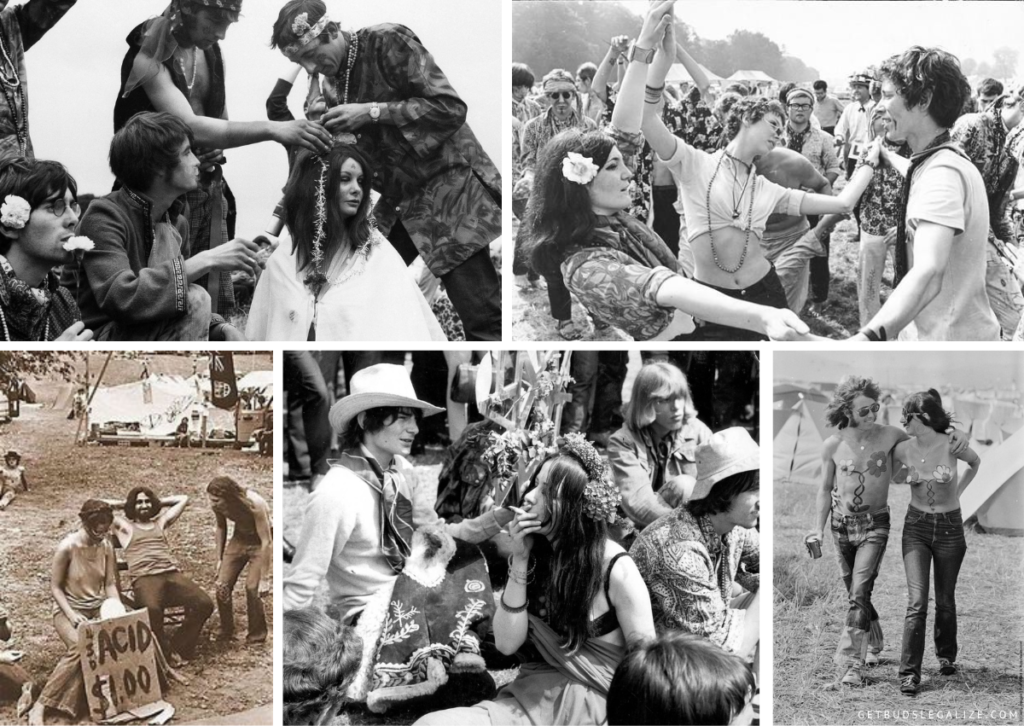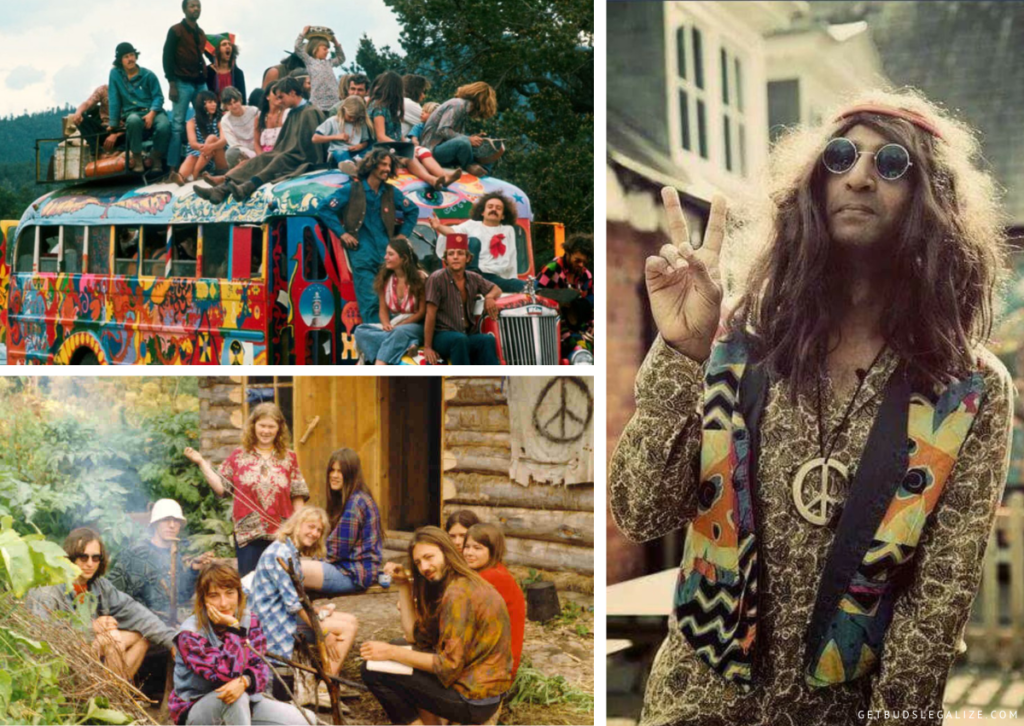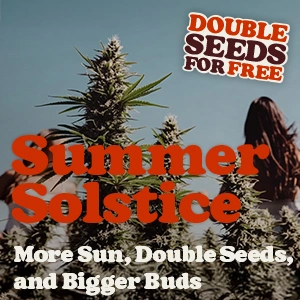The Stoner Culture of Hippies: A Historical and Sociological Perspective
The hippie movement was one of the most influential and radical counterculture expressions of the 1960s, which opposed the dominant values of Western society, especially consumerism, militarism, and discrimination.
Hippies were looking for an alternative life based on love, peace, freedom, and harmony with nature. To achieve this, many of them adopted a nomadic lifestyle, experimented with psychedelic drugs, practiced meditation and other forms of Eastern spirituality, and expressed themselves through music, art, and fashion.
Stoner culture is closely related to hippy culture, as both shared the use of cannabis as a means to broaden consciousness, relax and socialize. Cannabis was considered a sacred plant, capable of opening the doors of perception and connecting individuals with the divine. Stoner culture has evolved over time, taking on different nuances depending on the historical and social context in which it was inserted.
The Counterculture of The 1960s and The Dawn of New Age Consciousness
The counterculture movement in America began in the 1950s when some intellectuals, artists, and writers began to criticize the conformity and repression of post-war society.
Among these, the so-called Beatniks stood out, celebrating spontaneity, creativity, and rebellion. Beatniks were among the first to experiment with psychedelic drugs, such as LSD and psilocybin, which led them to explore new dimensions of mind and reality. Some of them also approached Eastern philosophies, such as Buddhism and Hinduism, which offered a more holistic and mystical view of existence.
The Beatniks profoundly influenced the next generation of young Americans, who in the 1960s were faced with a series of social and political problems, such as the Vietnam War, racism, poverty, and violence.

These young people felt alienated from mainstream society, which they deemed hypocritical, corrupt, and unjust. Thus was born the hippy movement, which set out to create a new culture based on the values of universal love, nonviolence, equality, and ecology.
The hippies were inspired by the Beatniks, but went further, turning their ideas into concrete actions. Many of them left the cities to live in self-managed rural communities, where they practiced organic farming, waste recycling, and solar energy. Others devoted themselves to political and social activism, participating in pacifist, feminist and environmentalist demonstrations. Still, others engaged in artistic and cultural expression, resulting in new genres of music (such as psychedelic rock and folk), new art forms (such as pop art and conceptual art), and new fashion styles (such as long hair, colorful clothes, and flowers).
The hippy movement was also at the forefront of the introduction of the so-called New Age, i.e. a spiritual current that mixed elements of different religious and philosophical traditions, such as occultism, esotericism, astrology, Gnosticism, Sufism, Taoism, and Shamanism.
The New Age was based on the concept of an Aquarian Age in which humanity would attain a higher level of consciousness and harmony with the universe. To help this process, hippies relied on psychedelic drugs, which they believed could expand the mind and heart, and meditative practices, which they believed could purify the body and soul.
Understanding The Counterculture Movement In America

To understand the counterculture movement in America, it is necessary to take into account several factors that led to its emergence, development, and decline. Among these, we can mention:
1. The Historical Context:
the 1960s were a time of great change and stark global contrasts. On the one hand, there were Cold War tensions between the United States and the Soviet Union, which led to the Cuban Missile Crisis, the Space Race, and the Vietnam War.
On the other hand, there were national liberation and decolonization movements in Africa, Asia, and Latin America, which challenged Western domination.
Furthermore, there were cultural and social revolutions in Europe, such as the Prague Spring, the French May, and the Italian Sixty-Eight. In this scenario, the hippies presented themselves as a third alternative way, which rejected both capitalism and communism and proposed a more humanistic and peaceful vision of the world.
2. The Social Context:

the 1960s were also a period of great transformations and strong internal conflicts. On the one hand, there were the economic and technological achievements of the United States, which made it the first world power.
On the other hand, there were social inequalities and racial discrimination that afflicted the American population. In addition, there were cultural and moral challenges that emerged from the spread of mass media, contraception, and psychoanalysis.
In this scenario, the hippies positioned themselves as a critical minority, which denounced the injustices and hypocrisies of American society, and proposed a freer and more open culture.
3. The Personal Context:
The 1960s were finally a period of great experiences and strong emotions on an individual level. On the one hand, there were educational and professional opportunities that opened up for young Americans thanks to the economic boom and population growth.
On the other hand, there were existential dissatisfactions and emotional frustrations that manifested themselves among young Americans, due to social pressure and lack of meaning.
In addition, there were expressive and creative possibilities that were offered to young Americans, thanks to cultural variety and artistic novelty.
In this scenario, the hippies presented themselves as an experimental generation, which sought to realize itself and express its personality through spiritual research and aesthetic innovation.
How Hippies Turned Into Anti-War Protesters

One of the events that triggered the transformation of hippies into anti-war protesters was the Vietnam War, which began in 1955 and ended in 1975. The Vietnam War was a controversial and unpopular war, resulting in millions of civilian and military deaths, and it was seen by many as a violation of human rights and a form of American imperialism.
Hippies opposed the Vietnam War because they believed it was immoral, unjust, and pointless, organizing numerous peaceful protests against it, such as marches, sit-ins, boycotts, and civil disobedience. The hippies also sought to raise awareness of the war through their alternative media, such as newspapers, magazines, posters, music, and art.
One of The Most Iconic Events That Exemplified Hippie Protest Was Woodstock
Woodstock was a music festival held from August 15 to 18, 1969 in Bethel, NY. This was the most significant rock music gathering in history, with over 400,000 people attending performances by famous artists such as Jimi Hendrix, Janis Joplin, The Who, the Grateful Dead, and many others.
Woodstock was also a symbol of the hippie counterculture, which celebrated the values of peace, love, and freedom, and was seen by many as a manifestation of opposition to the Vietnam War and violence in general. Woodstock was a historic event that marked the end of one era and the beginning of a new one.

A Strong and Deep Impact on American Culture
The Hippie movement has had a profound and lasting impact on American culture in various fields, influencing fashion, art, music, cinema, literature, religion, politics, ecology, civil rights, feminism, sexuality, and much more.
The Hippie movement helped create greater open-mindedness, tolerance, diversity, creativity, and social awareness in American society, leaving a legacy of values and ideals that continue to inspire subsequent generations.
FAQs about Stoner Culture
Hippies and stoners have influenced pop-culture in many ways, such as:
- Introducing new genres and styles of music, such as folk rock, psychedelic rock, reggae, rap, and grunge.
- Inspiring fashion trends, such as tie-dye shirts, bell-bottom pants, flower crowns, peace signs, and dreadlocks.
- Popularizing slang terms, such as groovy, cool, dude, trippy, chill, munchies, and 420.
- Creating iconic movies and TV shows, such as Easy Rider, The Big Lebowski, Cheech, and Chong, Dazed and Confused, That ’70s Show, and Pineapple Express.
- Raising awareness and activism on issues such as civil rights, feminism, gay rights, anti-war movements, environmentalism, and drug policy reform.
This is a term used in the cannabis culture to refer to the state of being high or intoxicated by marijuana and is often used as a positive expression of enjoyment or satisfaction with the cannabis experience.
Among the famous hippies have been many artists, musicians, writers, activists, and spiritual leaders who have embodied the spirit and values of the movement. Some examples are:
- John Lennon: Lead singer and songwriter of the Beatles, who wrote songs such as “Imagine” and “Give Peace a Chance”, which have become anthems of peace and love.
- Bob Dylan: Singer-songwriter and Nobel Prize in Literature, who influenced folk and rock music with his poetic and engaging songs, such as “Blowin’ in the Wind” and “The Times They Are a-Changin'”.
- Jimi Hendrix: Psychedelic rock guitarist and singer, who revolutionized electric guitar technique and sound with his virtuoso and innovative performances, such as “Purple Haze” and “Star Spangled Banner”.
- Janis Joplin: blues and rock singer, who expressed her emotions and life experiences in her powerful and scratchy voice, as in “Piece of My Heart” and “Me and Bobby McGee”.
- Timothy Leary: psychologist and writer, who promoted the use of LSD as a means to explore the mind and reach higher levels of consciousness, with his slogan “Turn on, tune in, drop out”.
One interesting question that arises from this historical overview is how cannabis use affects the social structure and behavior of different societies. This is not an easy question to answer, as there are many factors that influence the development and functioning of a society, such as geography, economy, politics, religion, ethnicity, etc. However, some general observations can be made based on existing research and evidence.
One possible difference between stoner and alcoholic societies is their level of aggression and violence. Some studies have suggested that cannabis use reduces aggression and hostility, while alcohol use increases them. This may be due to the different effects that these substances have on the brain and the body. Cannabis tends to induce relaxation, euphoria, and introspection, while alcohol tends to impair judgment, lower inhibitions, and increase impulsivity. Therefore, stoner societies may be more peaceful and cooperative than alcoholic societies.
Another possible difference between stoner and alcoholic societies is their level of creativity and innovation. Some studies have suggested that cannabis use enhances creativity and divergent thinking, while alcohol use impairs them. This may be due to the different effects that these substances have on the cognitive processes involved in generating novel and original ideas.
Cannabis may stimulate associative thinking, which allows for more connections and combinations of existing information. Alcohol may inhibit executive functioning, which regulates planning, organization, and problem-solving. Therefore, stoner societies may be more inventive and artistic than alcoholic societies.
Of course, these differences are not absolute or deterministic. There are many examples of violent stoner societies (such as the Mexican drug cartels) and creative alcoholic societies (such as the Irish literary tradition). Moreover, there are many other factors that influence a society’s culture and behavior besides its preferred intoxicant. Therefore, it is important to avoid stereotypes and generalizations when comparing stoner societies and alcoholic societies.
However, it is also important to acknowledge the role that cannabis has played in shaping some of the most influential and fascinating cultures in human history. Hippies are just one example of a stoner society that left a lasting mark on the world with their ideals, values, and aesthetics. By studying hippies from a historical and sociological perspective, we can better understand ourselves and our society.
Stoners have developed their own vocabulary to describe various aspects of cannabis culture, such as:
- Weed: A general term for cannabis, derived from its appearance as a dried herb.
- Pot: Another common term for cannabis, derived from its Spanish name “potiguaya”.
- Marijuana: A term for cannabis that originated in Mexico and became popularized in the US during the prohibition era.
- Ganja: A term for cannabis that originated in India and is associated with the Rastafari movement.
- Herb: A term for cannabis that emphasizes its natural origin and medicinal value.
- Grass: A term for cannabis that refers to its green color and plant-like appearance.
- Bud: A term for cannabis that refers to the part of the plant that contains the highest concentration of cannabinoids, also known as the flower or nugget.
- Joint: A term for a rolled cigarette containing cannabis, also known as a spliff or doobie.
- Blunt: A term for a rolled cigar containing cannabis, usually made with tobacco leaves or wraps.
- Bong: A term for a water pipe used to smoke cannabis, also known as a bubbler or hookah.
- Bowl: A term for a small pipe used to smoke cannabis, also known as a spoon or chillum.
- Vape: A term for an electronic device used to vaporize cannabis oil or dry herb, also known as a vaporizer or e-cigarette.
- Edible: A term for a food or drink infused with cannabis oil or butter, also known as a medible or treat.
- Tincture: A term for a liquid extract of cannabis that can be taken orally or sublingually, also known as a drop or spray.
- Topical: A term for a cream or lotion infused with cannabis that can be applied to the skin, also known as a salve or balm.
To understand 420 meaning origins, we need to go back to the early 1970s, when a group of high school students in San Rafael, California, known as the Waldos, would meet at 4:20 p.m. to smoke cannabis.
They used the code word “420” to communicate their plans without alerting others. The term spread among cannabis enthusiasts and became associated with April 20, a date that many people celebrate by consuming cannabis products.
Stoner movies feature cannabis use as a central theme or plot device. They often depict the humorous and absurd situations that stoners encounter or create.
Some of the classic 70s stoner movies are Cheech and Chong’s Up in Smoke, Dazed and Confused, and The Big Lebowski. Some of the contemporary examples are Pineapple Express, Harold and Kumar Go to White Castle, and The Hangover.
Stoner or weed culture is a term that refers to the subculture of people who consume or smoke weed, for recreational or medicinal purposes. Weed, also known as cannabis, marijuana, pot, or herb, is a plant that contains psychoactive compounds that can alter one’s mood, perception, and cognition. Stoner culture encompasses various aspects of lifestyle, art, music, fashion, humor, and activism that are influenced by or related to weed consumption.
Stoners are people who use cannabis, a psychoactive plant that can have various effects on the mind and body. However, stoners are often subject to stereotypes and misconceptions that are not based on facts or evidence. Some of these stereotypes and misconceptions are:
- Stoners are lazy and unproductive. This is not true, as many stoners are successful in their careers, hobbies, and personal lives. Cannabis can actually enhance creativity, focus, and motivation for some people, depending on the strain and dosage.
- Stoners are unintelligent and ignorant. This is also false, as many stoners are well-educated, well-informed, and curious about the world. Cannabis can stimulate cognitive functions, such as memory, learning, and problem-solving, for some people, depending on the strain and dosage.
- Stoners are irresponsible and reckless. This is another myth, as many stoners are careful and conscientious about their cannabis use. They follow the laws and regulations of their jurisdiction, they consume cannabis in moderation and with caution, and they respect the rights and preferences of others.

















